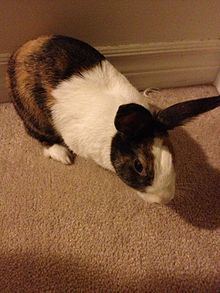Rank Breed | ||
 | ||
Similar Deilenaar, Beveren, Havana, Blue of Sint‑Niklaas, Miniature Lion Lop | ||
The Tri Colour Dutch (also known as Japanese Dutch or Harlequin Dutch) was first created in the Netherlands by crossing tortoiseshell Dutch rabbits and harlequin rabbits. This breed is recognized by the British Rabbit Council but not the American Rabbit Breeders Association, although there are breeders of Harlequin Dutch in the USA. The rabbit should have white in the same place as a Dutch but the coloured parts should be a mix of orange with either black, blue or chocolate.
UK Breed Standard:
1. Body and type - Body is cobby, head held well between shoulders, which are firm and well muscled. Ears strong, well carried, length not to exceed 10 cm (4 inch). Chest wide and well formed. Front feet medium length—Straight and fairly fine bone. Back feet held parallel to body. Pattern on head - Cheeks well rounded must not touch whisker bed or corners of mouth or over past the cheekbone
2. Design and colour - One cheek must be orange-the other cheek black with ears black on orange side and orange on black cheek side. Blaze is white. It commences as a point starting from near the ear roots and gradually widens evenly passing between the eyes on to the neck and nape. This white must be as wide as possible. Must not pass between the ears. The saddle must make a true ring around the body and be placed 2–3 cm (3/4-1.1/4 inches) behind the front feet. The coloured half must be 2–3 cm (3/4-1.1/4 inches) banded as regularly as possible with alternating bands of black and orange. Stops regular. Colours- Also recognisable, blue to replace black, chocolate to replace black,
3. Fur - Thick and lustrous with plenty of under coat and guard hairs. Weight- 1.70-2.5 kg (3.3/4- 5.1/2 Lb.
Faults
Coloured fur on white part or white patches on the coloured parts. DISQUALIFICATIONS -Discoloured or wall eyes (pale blue iris), specked eyes (pale blue spots or specks on the iris). Flesh markings (usually on ears). Trimming (attempts to straighten out irregularities, dyeing white spots on coloured fur, etc.). Malocclusion and mutilated teeth.
